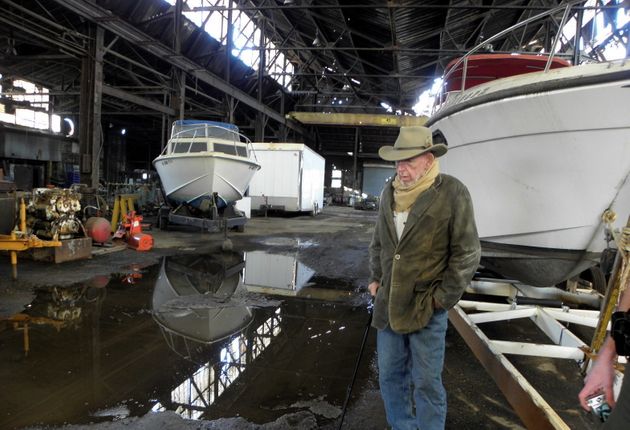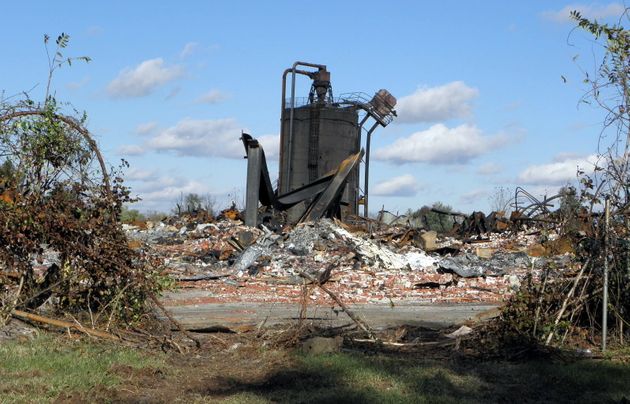What remains of the International Import Export warehouse is 10 acres of hulking twisted metal, reminiscent of a war zone. Thick layers of ash, brick and metal hover more than head-high for several hundred yards along a semi-rural road just outside the city limits.
Residents of this bustling Ohio River city of more than 30,000 people should be breathing a bit easier now that the fire is finally out ― but many don’t feel that way.
“Our throats were burning,” said Jameeka Graham, 22, a lifetime Parkersburg resident. “It just smelt like it would be bad for us.”
The Agency for Toxic Substances and Disease Registry, a federal public health agency, reported late last week that the cough-inducing, chemical-tasting smoke that enveloped downtown and many other parts of the city was moderately high in small particles of carbon, similar to a wildfire.
But the ATSDR said the towering clouds of smoke did not contain significant levels of the toxic chemicals that burning plastics can emit, such as cyanide and formaldehyde, that could have long-term health impacts.
Camden Clark Medical Center, the city’s hospital, reported about 100 cases of suspected smoke inhalation during the weeklong fire. Director of Emergency Services Susan Abdella said the hospital handed out hundreds of free surgical masks after county health officials warned about about air quality conditions for anyone with respiratory ailments and people who worked outside. The hospital is also planning to follow up with free pulmonary assessments for first responders and community residents later this month.
Graham said many residents who came to the west Parkersburg Mexican restaurant where she works were wearing the masks.
“They had canceled every building downtown government-wise. Everybody was off work for that week,” said Graham. “So it had to be more serious than what they were saying.”
On top of lingering air quality concerns, another question looms: why state regulators allowed operations to continue at multiple sites owned by the same company, despite the repeated warnings and fines for water quality and fire code violations.
Stephen Mohwish, who owns a bar about three blocks north of the burn site, says he has made numerous complaints about another one of the company’s warehouses across the street, but heard nothing back from state officials.
“This is what we was breathing,” said Mohwish, holding out two blackened air filters he replaced at his bar after the fire. “That’s what we was breathing all week. I think the DEP [West Virginia Department of Environmental Protection] and EPA [Environmental Protection Agency] both should have monitored the facility better than what they did.”
The DEP has no record of Mohwish complaints ― or anyone else’s ― about the facilities, said West Virginia Department of Military and Public Services public information officer Lawrence Messina.
But those allegations should have triggered an investigation from both the state DEP and the EPA under the Right-To-Know program, part of a federal law that provides workers and communities the right to know what chemicals are being used in their vicinity. The program requires businesses operating with hazardous substances on site to submit annual reports of their chemical stockpiles to both state and federal agencies. They are also required to alert local emergency responders.
The Naik family has operated the International Import Export warehouse since 2004. Saurabd Naik of Maryland owns the parent company, SirNaik. International Import Export and another subsidiary, Polymer Alliance Services, operate several other warehouses in the Parkersburg area.
Naik’s son, Sonny Naik, was in Parkersburg during the fire and attended some of the public meetings. When HuffPost finally reached him for comment on Sunday, Naik responded to questions with only “do some research,” and then hung up the phone.
Messina said no hazardous chemical inventory reports have any been filed for any of the warehouses the family owns.
The West Virginia DEP had inspected the IEI warehouse multiple times between 2011 and 2017. In 2015, DEP fined the owners more than $80,000 for violations to water quality under the National Pollutant Discharge Elimination System permit program, a federal program the EPA oversees that regulates the discharge of pollutants into waterways. On the day the fire started, more than $60,000 of those fines had yet to be paid.
Even well before then, in 2008, two Wood County volunteer fire chiefs ― one a West Virginia assistant fire marshal ― wrote a letter to the agency overseeing state fire marshals that detailed concerns about fire code violations at a different facility owned by the Naik family south of Parkersburg. They said the site was inaccessible to firefighters, citing plastics stacked so high that sprinkler systems were rendered ineffective. And they warned that conditions at the Parkersburg facility that caught fire last month raised similar concerns.
The fire began at about 12:30 a.m. on Oct. 21 in the sprawling complex of aging warehouses on Camden Avenue just outside the Parkersburg city limits.
According to state DEP records, thousands of tons of shredded sheet- and pellet plastics, along with rusting drums of unknown chemicals, were stored both inside and outside of the warehouse.
County Commissioner President David Blair Couch arrived at the scene early Oct. 22 to find the entire structure in flames.
“So I stand and look up and the smoke’s over me and I’m maybe less than a hundred yards from the flames,” said Couch. “And I don’t have a sense, I mean, of the humongousness of it. It’s hard to gauge.”
Couch spent most of the next week on the site, as volunteer and paid firefighters from around the county battled the blaze. By 3 p.m. the afternoon Oct. 22, Couch says, it was clear the men and women battling the blaze weren’t making headway.
“They were pouring water, approximately 6 million gallons on the first day,” said Couch. “They had the Marietta fire boat come down the Little Kenawha River behind the property and provided a pump out of the river boat and ran 10-inch hoses from the river.”
But that still wasn’t enough. Couch decided it was time to call in a team of contractors from the city of Washington, Pennsylvania, about two hours away. The contractors from SPSI, a private firm that specializes in hazardous material emergency response, estimated it would take up to two weeks to put out the fire and their services would run between $65,000 and $75,000 per day. Couch hired them after the governor’s office said the state could reimburse the county for the costs.
Experts from the National Oceanic and Atmospheric Administration were also on site to help forecast weather conditions, which helped the county health department determine which neighborhoods the smoke would most affect. There were also three contractors working for the EPA on site taking air quality readings, as well as an EPA “sniffer” plane, which can sample air directly over a fire, taking aerial air quality readings. County commissioners also hired a private firm from Arkansas to assess long-term air quality.
Eight and a half days and nearly $2 million dollars later, the fire was declared out.
Couch said his anger is mostly directed at the warehouse owners, who failed to take responsibility, even while the fire was raging. Company owner Saurabd Naik was out of the country at the time, and his son only occasionally showed up at public meetings, said Couch. When he did, he seemed more concerned about the company’s liability for the costs the county was incurring to fight the fire than about the impacts to public health and safety, Couch said.
“They’ve shown me nothing,” said Couch. “They haven’t walked in here with one single check, or a box of doughnuts, or ‘Here, we’re putting money in an escrow account to make the county whole.’”
The West Virginia DEP has given the company until the end of the day on Monday to submit a plan for environmental cleanup of the burn site. Messina said the state DEP is not ruling out any regulatory options, including going to court, to ensure compliance with its orders and regulatory requirements, but they are focused on continuing the dialogue with the company to reach an agreement.
But that doesn’t satisfy some Parkersburg residents, including Stephen Mohwish.
“I would really like to see him closed down and out of this community,” said Mohwish. “I don’t like to see these chemical things being stored right in my hometown.”


